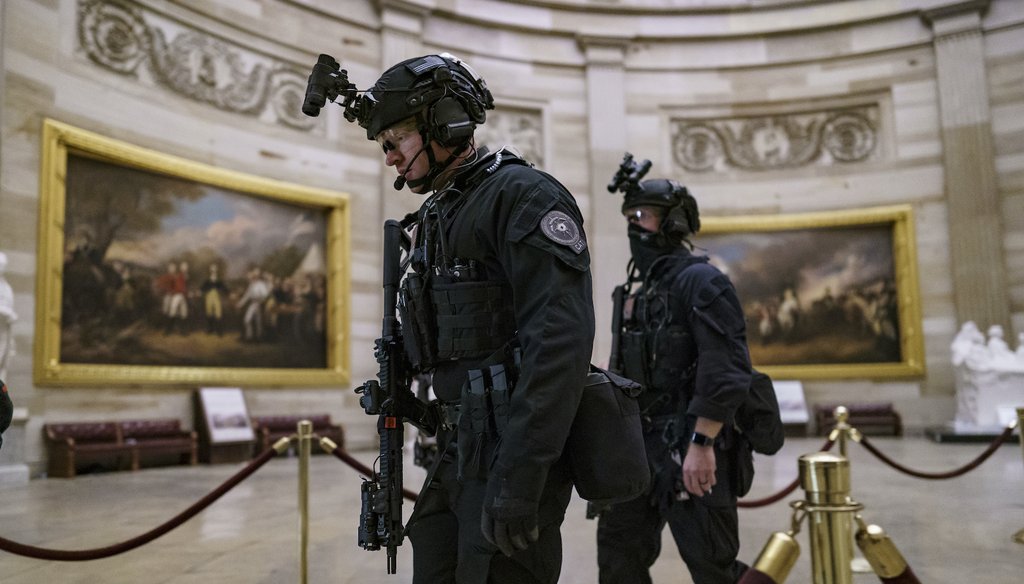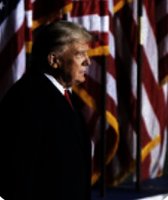Stand up for the facts!
Our only agenda is to publish the truth so you can be an informed participant in democracy.
We need your help.
I would like to contribute

Members of the U.S. Secret Service Counter Assault Team walk through the Rotunda as they and other federal police forces responded as violent protesters loyal to President Donald Trump stormed the U.S. Capitol. (AP Images)
If Your Time is short
-
Early in the Black Lives Matter protests in Washington, D.C., police used methods designed to dominate the crowd, including chemical irritants and lines of police in full riot gear charging at protesters.
-
As rioters stormed the Capitol building in January, Capitol Police forces were quickly overwhelmed and showed relative restraint in the immediate aftermath of the attack.
-
Federal and D.C. forces planned for unrest from Black Lives Matter protesters. Capitol Police planned for a peaceful demonstration by Trump supporters.
-
Crowd control experts say that once Capitol Police were overwhelmed, de-escalation tactics held the best hope of ending the conflict.
The police response to the assault and vandalism of the federal Capitol building has unleashed a wave of comparisons to the summer Black Lives Matter protests in Washington, D.C.
President-elect Joe Biden said the restrained handling of the Trump supporters at the Capitol reflected unequal justice. His granddaughter had sent him a photo of row upon row of soldiers in riot gear guarding the Lincoln Memorial taken in June.
This photo by @MarthaRaddatz at the Lincoln Memorial is deeply disturbing. pic.twitter.com/4cUgxQKh2p
— Eli Clifton (@EliClifton) June 2, 2020
"No one can tell me that if it had been a group of Black Lives Matter protesting yesterday, they wouldn’t have been treated very, very differently than the mob of thugs that stormed the Capitol," Biden said Jan. 7.
There is no way to know how events might have unfolded differently if the protesters’ cause on Jan. 6 had been police brutality rather than supporting a president who lost an election. But we can put the clashes side by side.
Already, we’ve documented major differences in the initial posture of police and how both conflicts took shape. And there is no escaping that the people the police faced looked different in the two situations. People of color and whites came out for Black Lives Matter, while whites predominated among the Trump supporters.
Domestic protest researchers said that in the summer, the deployment of forces revealed the official belief that the Black Lives Matter crowd represented a threat, and police took steps to prevent violence. In contrast, despite many red flags, the U.S. Capitol Police expected a largely peaceful protest from Trump’s backers.
That expectation set the stage for the chaos that followed.
After Minneapolis police killed George Floyd, Black Lives Matter protests spread across the nation. On Friday, May 29, around 1,000 people marched through D.C. to call for justice and an end to police brutality. Tensions flared when some protesters stopped at the White House, pushing down metal barriers that separated them from law enforcement before the march continued on through the city.
Around 11:30 p.m. that night, a more intense round of protests took place outside the White House, and Secret Service, D.C. police, and park police used chemical agents to disperse demonstrators. The crowd split apart around 3:30 a.m. after a line of officers advanced through Lafayette Park, holding shields and firing chemical agents.
News outlets reported that the White House briefly went into lockdown, and that Trump was rushed to an underground bunker. However, no protesters penetrated the grounds.
The next day, Trump tweeted that protesters would have met with "vicious dogs" and "ominous weapons" if they had breached the enclosure. He also appeared to invite his supporters to clash with protesters outside the White House.
In the days that followed, police officers used tear gas, horse-mounted charges, pepper spray, shields, batons and rubber bullets on protesters and journalists covering the demonstrations.
Nearly 300 protesters were arrested on the night of Jun. 1. By the end of the week, 5,800 active-duty troops, agents and officers from a mixture of federal agencies – including the Bureau of Prisons, the U.S. Marshals Service, and Immigration and Customs enforcement – had been deployed to the city. Then-Secretary of Defense Mark Esper referred to the city as a "battlespace" on a call with governors. Armored vehicles patrolled the streets, and helicopters sank low over protesters, generating winds strong enough to shatter glass. The crackdown was aggressive, but no protesters or police died in the District, according to lists of deaths related to the protests compiled by Forbes and the Associated Press.
Fast forward from June to Jan. 6.
When Trump supporters walked up to a portable metal barricade on the Capitol grounds, they saw a handful of officers in their regular uniforms standing on the other side. In the first moments, there was little sense that the marchers would plow through.
The moment it all began. pic.twitter.com/gdyx9Udgc6
— Philip Crowther (@PhilipinDC) January 7, 2021
But as soon as one person decided to press on, the momentum swelled. The marchers and officers struggled over control of the barricade. The weight of the crowd soon sent officers sprawling backwards. A marcher punched an officer. An officer punched a Trump supporter, and the march became a riot. The police ran back towards the Capitol building, with the mob running close behind.
By 1:15 p.m, a line of police were tussling with Trump supporters on the steps of the Capitol. Rioters shoved police officers, spraying chemical irritants and hitting them with lead pipes. Police deployed flash bangs and pepper spray in an attempt to ward off the crowd.
At 1:46 p.m, Rep. Elaine Luria was evacuated from her office after a report that a pipe bomb had been discovered nearby. "Supporters of the president are trying to force their way into the Capitol and I can hear what sounds like multiple gunshots," she tweeted.
At 2:11 p.m, rioters penetrated the police perimeter on the west side of the Capitol and began to climb the walls. A male intruder shattered windows at the south side of the building and climbed inside with other members of the mob. Ten minutes later, Vice President Mike Pence was escorted from the Chamber.
A video posted to Twitter at 2:21 p.m shows rioters breaking the glass on the doors of the Capitol. Minutes later, police were photographed attempting to talk down the mob after tear gas was set off inside the building. Capitol Police escorted lawmakers and journalists from both the House and Senate Chambers to secure locations. An armed standoff between police and rioters occurred at the doors of the House Chamber. Rioters gained access to the Senate Chamber and paraded around the room.
Around 2:45 p.m., a plain-clothed Capitol Police Officer shot a woman as she attempted to break into the Speaker’s Lobby. The woman – later identified as Air Force veteran Ashli Babbitt – eventually died from the injuries.
Around 3 p.m. the Army Secretary Ryan McCarthy activated the entire D.C. National Guard. Agents from the FBI, U.S. Marshal Service and the Bureau of Alcohol, Tobacco, Firearms and Explosives were deployed to gain control of the building.
An officer told CNN that police had cleared the Senate floor of rioters by 3:30 p.m., although protesters were still massing in other parts of the building. According to the sergeant-at-arms, the Capitol was finally cleared at 5:40 p.m., 20 minutes before Washington’s curfew set in.
After curfew, law enforcement officers clad in body armor began to use aggressive tactics similar to the ones they had used on Black Lives Matter protesters, advancing on rioters and whacking them with batons.
According to Robert J. Contee III, chief of the city’s Metropolitan police department, 68 individuals were arrested over the course of the night, mostly for violating the curfew order.
The next day, Capitol Police Officer Brian Sicknick died from injuries sustained from engaging with rioters.
In the view of Rep. Tim Ryan, D-Ohio, head of the House committee that controls the Capitol Police budget, the assault on the Capitol stemmed from a false premise behind Capitol Police planning.
Ryan said that a week before the march, the Capitol Police assured him that everything was under control. Ryan said he was told they expected a "pretty vanilla" protest.
"There wasn't going to be any kind of violence anticipated," Ryan said. "Maybe some dust-ups. Maybe issues around people trying to get guns into the District of Columbia, where they have very strict gun laws, but absolutely nothing like this."
The people who study crowds and police say there was ample reason to plan for a much more aggressive group.
"There was clear intelligence about where this was headed," said Arizona State University criminologist Ed Maguire. "All you had to do is go on Parler (the alt-right social media platform) for 10 minutes. I was on the night before. They were talking about violence. This is open source material, and the police would have had more."
Just a month earlier, a Dec. 12 pro-Trump rally had attracted members of the Proud Boys, a violence-prone group that showed up again on Jan. 6. In December, they were involved in street fights that led to multiple stabbings. The D.C. mayor urged residents to stay home and avoid any confrontation with people coming to the rally.
Ryan said rioters on Jan. 6 came armed with metal pipes and pummeled officers, sending a half dozen to the hospital with head injuries.
The outnumbered and poorly equipped Capitol Police fell back. The mob freely entered the Capitol, and once inside, researchers say the police had limited options to end the chaos.
That situation produced the scenes that have drawn the harshest comparisons to the Black Lives Matter protests. Heavily armed police hugged the walls as the mob swirled past them. One helped a rioter down the steps as she left the building. Another paused as a departing rioter snapped a selfie with a Capitol Police officer.
The grave exception to that atmosphere was when an officer shot and killed a woman as she tried to enter a secure area.
Initially, the police arrested 14 people for unlawful entry to the Capitol. The number grew to about 40. While that is a small fraction of the hundreds that were part of the mob, it is on the same scale as the first arrests of Black Lives Matter protesters — six on the first night and 19 on the second, with hundreds more in the days that followed. (Ryan said U.S. attorneys are tracking down others who breached the Capitol and more charges are expected.)
But as much as the limited effort to make arrests, it’s the casual demeanor of police that has angered Black Lives Matter supporters. They point to that image of soldiers at the ready at the Lincoln Memorial, and the line of officers firing pepper balls and charging at protestors in front of the White House.
Maguire said the comparison is valid. The only reason to use that riot gear and those weapons, he said, is to intimidate the crowd.
"How the Trump administration handled the BLM protests was draconian and outrageous," Maguire said. "Flexing military muscle and trampling peoples' rights. We had a massive over-response."
But the problem on Wednesday was a massive under-response, he said. It’s fine to start with officers wearing a "soft" uniform, because that tends to de-escalate tensions. But out of sight, officers in hard riot gear should be nearby, he said.
After Capitol Police lost control, de-escalation became the prime option, said University of Texas-Austin professor Michael Sierra-Arévalo.
"Tactically speaking, it would be really hard to make an arrest happen when you’re by yourself," Sierra-Arévalo said. "That explains why you didn’t see an escalation of force, until later on, when we saw an influx of law enforcement personnel."
One other factor likely shaped the responses of police at the Capitol in ways different from the Black Live Matter protests. That’s the perceived attitude toward the police.
"Black Lives Matter is viewed synonymously among many police as being anti-police," Sierra-Arévalo said. "Some view it as an existential threat to their job, their profession, and in some cases to their very lives. That’s not something that’s going to be as near the fore when you’re looking out into the crowd and you can quite literally see Blue Lives Matter flags flying somewhere."
The chief of the Capitol Police announced he would resign in a week, and two other top officials responsible for security at the Capitol stepped down.
Our Sources
ABC News, DC Mayor holds press conference on Capitol Hill siege, Jan. 7, 2021
Abdallah Fayyad, Tweet, Jun. 1, 2020
Alejandro Alvarez, Tweet, May 29, 2020
Associated Press, Retired officer, ex-college athlete among victims of unrest, Jun. 2, 2020
Bellingcat, Twitter Thread, Jan. 7, 2021
CNN, DC Mayor asks Trump to 'withdraw all extraordinary' law enforcement and Guard troops from city, Jun. 5, 2021
CNN, US Capitol secured, 4 dead after rioters stormed the halls of Congress to block Biden's win, Jan. 7, 2020
Donald J. Trump, Tweet, May 30, 2020
Donald J. Trump, Tweet, May 30, 2020
Forbes, 14 days of protests, 19 dead, Jun. 8, 2020
Igor Bobic, Tweet, Jan. 6, 2021
Igor Bobic, Tweet, Jan. 6, 2021
Interview, Edward Maguire, professor, School of Criminology and Criminal Justice, Arizona State University, Jan. 7, 2021
Interview, Michael Sierra-Arévalo, professor of sociology, UT Austin, Jan. 7, 2021
Jim Newall, Tweet, Jan. 6, 2021
Kenneth P. Vogel, Tweet, Jan. 7, 2021
Manu Raju, tweet, June 3, 2020
Metropolitan Police Department, May 2020-January 2021 unrest-related arrests and persons of interest, Jan. 8, 2021
NBC News, 4 dead, Congress evacuated, National Guard activated after pro-Trump rioters storm Capitol, Jan. 6, 2021
New York Times, As protests and violence spill over, Trump shrinks back, May 31, 2020
NPR, Protesters were supposed to hear warnings before federal police moved in. They didn’t, Sep. 11, 2020
Philip Lewis, Tweet, Jan. 6, 2021
Politico, The Story Behind Bill Barr’s Unmarked Federal Agents, June 5, 2020
Rep. Elaine Luria, Tweet, Jan. 6, 2021
Rep. Tim Ryan, Press briefing, Jan. 7, 2021
Rev, Joe Biden introduces DOJ nominees, Merrick Garland, transcript, Jan. 7, 2021
Roll Call, Protesters flood Capitol Hill and across Washington, lawmakers among them, June 7, 2020
USA Today, Timeline: How a Trump mob stormed the US Capitol, forcing Washington into lockdown, Jan. 7, 2020
Sunrise, Tweet, Jun. 1, 2020
Timothy Burke, tweet, Jan. 6, 2021
USA Today, Timeline: How a Trump mob stormed the US Capitol, forcing Washington into lockdown, Jan. 7, 2021
U.S. Capitol Police, Statement, Jan. 7, 2021
U.S. Secret Service, Statement on Pennsylvania Avenue demonstrations, May 30, 2020
Washington Post, A video timeline of the crackdown on protesters before Trump’s photo op, Jun 8, 2020
Washington Post, Capitol breach prompts urgent questions about security failures, Jan. 6, 2021
Washington Post, Demonstrations for George Floyd lead to clashes outside White House, May 30, 2020
Washington Post, Head of committee overseeing Capitol Police decries ‘enormous strategic and planning failures’, Jan. 6, 2021
Washington Post, How a pro-Trump mob was able to storm the Capitol, Jan. 7, 2021
Washington Post, Humvees, helicopters and the National Guard: D.C. officials push back on show of federal force on city streets, Jun. 4, 2021
WTOP, Tweet, Jan. 7, 2021
WUSA, Tear gas deployed in Senate chamber as Trump supporters storm Capitol, Jan. 6, 2020
NBC News, Capitol Police officer dies from injuries after clashing with pro-Trump mob, Jan. 7, 2021



















































